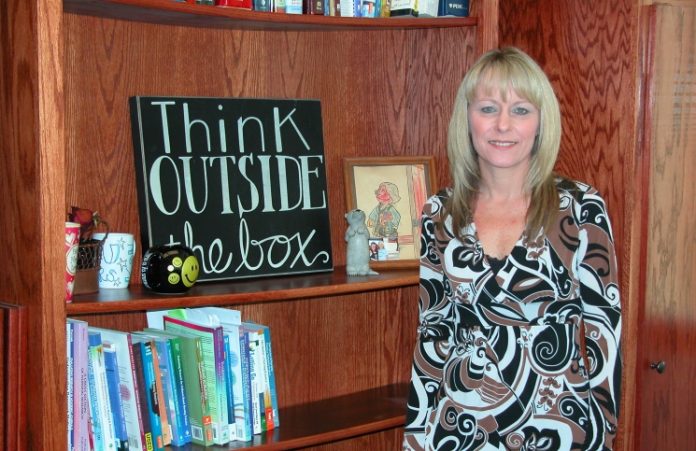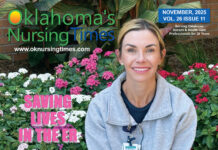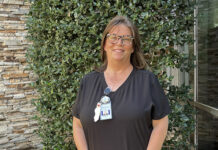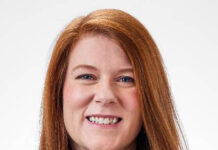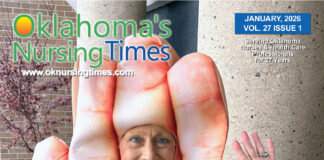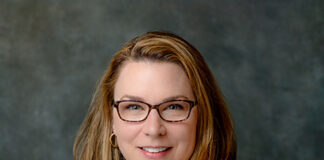by James Coburn
Staff Writer
Gina Crawford, RN, DMP, was the inquisitive one out of five children.
Her father, the late Dr. Thomas Stough was a physician in Okarche. She would spend a great deal of time following him around in his practice going to the hospital and talking to the nurses, said Crawford, wholesale jerseys a certified nurse practitioner and clinical instructor for the Family Nurse Practitioner program at Kramer School of Nursing, Oklahoma City University
He was a small town family practice doctor, the third generation of physicians in Crawford’s family.
“He was a great mentor in clinical practice with him,” she said of her dad, who had been in practice for 45 years.
Crawford’s mother was a nurse and her uncle was also a physician. There wholesale nfl jerseys is a long family history from the medical community, she said. So it’s not difficult to understand why she developed an aptitude for nursing at an early age.
“I knew that I wanted to work in the health profession in high school,” she said. “I wasn’t real sure how Careers that looked at 18 because I started nursing school when I was 19.”
She graduated from an associate nursing degree program in 1989 from El Reno Junior College, which is now Redlands Community College. For several years she worked at Mercy Hospital in the Pediatrics and Maternal Child unit. Later she worked in home health as a nurse and manager.
“And then I went back and finished my Bachelor of Science in Nursing at the University of Oklahoma,” she said. “I went on to graduate school at ONSA OU and finished my master’s as family nurse practitioner.”
Crawford returned to Okarche and worked as a family nurse practitioner Seattle Seahawks Jerseys with her father in her home town for cheap nfl jerseys seven years until 2012.
She always wanted to teach. Kramer School of Nursing was creating a new program that was suitable for her nursing expertise. The previous director was somebody she knew. So she spoke with him and became more interested in the program
“I’m happy I came” Crawford said. “Kramer is very supportive of their students. They expect the faculty to be accessible and available to their students, which I think is a very positive attribute for a program. It was Dark an opportunity to come here and teach nurse practitioners how to learn to be nurse practitioners.”
The Doctor of Nursing Practice program she teaches allows students to begin with a bachelor’s degree in nursing and finish with their doctorate. Then they are eligible to take their examination to be certified as a family Annual nurse practitioner. To A certified nurse practitioner who has a master’s degree can come back through Kramer’s completion track to earn their Doctorate in Nursing Practice, she continued.
There has been a lot of discussion on the federal level about changing the rules for having a Doctorate in Nursing Practice degree, but it has not become a regulation at this time.
“They talked about changing it in 2015, but that has been put on hold,” Crawford said.
Kramer graduated their first class in the program in 2014 with 10 students. Each of them passed their certification exam the first time.
“That was very good,” she said. “Then Issue currently the class that will be graduating in 2016 has 22 students.”
More nurse practitioners are needed in Oklahoma as there is a shortage of primary care providers in the state with most of the shortage in rural parts of the state, Crawford said.
“Nurse practitioners have been found to be very good primary care providers,” Crawford explained. “It’s what we’re educated to be. So as that shortage continues to grow, you are seeing more of a need for nurse practitioners in underserved-areas.”
Nurse practitioners are seen everywhere these days. When Crawford first went into practice in Okarche, the area had never had a nurse practitioner. A lot of education was necessary to share with the public about the role of a nurse practitioner. Now, the Okarche community has four nurse practitioners offering their services, Crawford said.
“How we educate our students, our philosophy has a strong foundation in health promotion, disease prevention and education, and how to not just treat your diseases with screening,” Crawford said. “We do a lot of education towards health behavior change, so if we identify a risk or a health behavior problem, we help those patients understand what those risks are and what they need to do to prevent disease, not just treat the disease after it has already been diagnosed.”
Crawford smiled when asked what she likes to do her leisure time. She is an avid reader of books and likes being outside, she said.
“I’m trying to find time to travel and go more places I haven’t been,” she said. “I volunteer at a free clinic and see uninsured patients. I love baseball and the Oklahoma City Thunder.”


